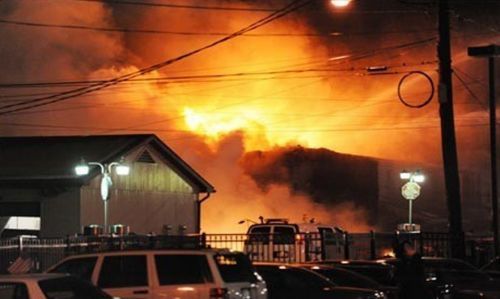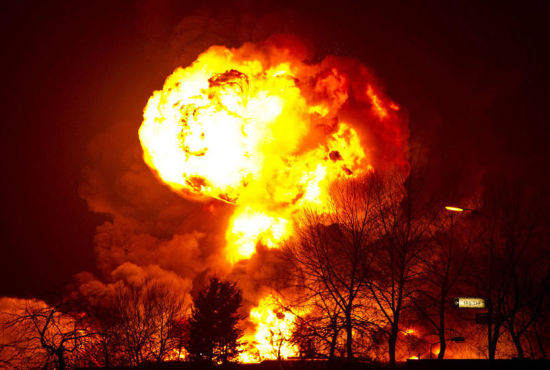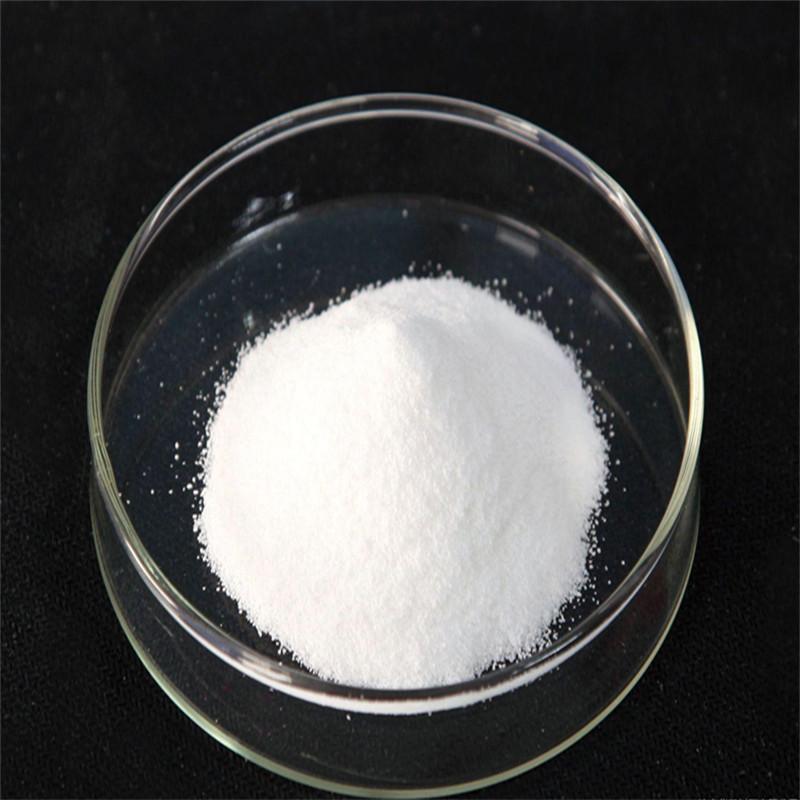Lessons from the US explosion of dangerous chemicals
Just around 11:30 pm on Wednesday, there were two violent explosions in a dangerous chemical product stack in Tianjin Binhai New Area, only 30 seconds apart. At present, 17 people were killed and more than 400 people were injured. Within two kilometers of the explosion point. The building glass was completely shattered and some people in the nearby buildings were trapped.
A video taken by a Tianjin netizen stung my eyes: From the lens he shot on the high-rise, some distance was on fire, and suddenly a small explosion made him scream, but he didn’t expect a big bang soon. The sky was red, and the building in front of the camera was covered in an instant. The shock wave turned him to the ground, and the lens was messy...
The same scene took place on April 17, 2013 in Texas, USA. A couple of local couples were shooting in the car at a distant chemical plant. After 30 seconds, a sudden explosion occurred at the fire site. A nearly 100-foot-wide fireball vacated and a strong shock wave caused two people to be injured. The screen was dark and I could only hear the girl always shouting: "I can't hear you, I can't hear, just leave this place and leave this place."

The final investigation showed that there was no "human-induced factor", and it was more inclined to be an industrial accident. The factory contained a giant fertilizer tank containing anhydrous ammonia, the main raw material for chemical fertilizer, and stored a large amount of ammonium nitrate. . According to investigators, the explosion occurred in the area where chemicals were stored, most likely a chemical reaction of ammonium nitrate, triggering an explosion.
Then, is there any leakage in the management of the fertilizer plant before the explosion? Who is the regulator of high-risk products such as fertilizer plants? Why the chemical fertilizer plant will be built so close to the two schools, these are the accountants who are shocked by the accident and accountable to the responsible party.
Is there any leak?
Unfortunately, the chemical fertilizer plant was found to be operating a loophole: suspected of illegal storage of dangerous goods, dangerous goods reserves exceeded the government's minimum of 1350 times reported, but did not report to the Department of Homeland Security as required, resulting in this federal agency until the explosion It happened that I learned about the existence of this fertilizer plant.
According to regulations, the fertilizer plant must notify the US Department of Homeland Security ((ammonium nitrate, which can be used to make bombs) if it holds more than 400 pounds of ammonium nitrate, but this fertilizer plant actually stores 270 tons of ammonium nitrate, yes, tons! The Department of Homeland Security is unaware of it because it was only filed in the National Health Service in Texas.
At the same time, the fertilizer plant also stored 270 tons of anhydrous ammonia, which greatly exceeded the reported standard of 180 kg and was not reported to the Department of Homeland Security. The problem is that the state health department and the Department of Homeland Security do not have a mechanism to share this data.
So, isn’t the data disclosure incomplete and the internal management loopholes in the government not a secondary cause of the explosion?
Who is supervising?
According to US legal and regulatory requirements, at least seven different state and federal agencies have the authority to regulate Texas Fertilizer Plants, including the US Occupational Safety and Health Administration, the Environmental Protection Agency, the Department of Homeland Security, the US Pipeline and Hazardous Materials Safety Administration. National Health Service, Texas Environmental Quality Council and Texas Feed and Fertilizer Control.
The Department of Homeland Security has the right to inspect such enterprises on the ground, but only fulfills this responsibility within the limits of budget and human resources, and the company’s reporting relies entirely on “consciousnessâ€. It is precisely the seven intensive regulatory networks that are not conducive to overall supervision, and there is a “management vacuumâ€.
Regulators have been bitter about this, claiming that they are regulated in the factory as required, but the media believes that “they seem to be only supervising certain aspects of plant operations, such as compliance with labeling rules when packaging fertilizer products.†In fact, how to regulate and store the regulation of these high-risk chemicals is crucial.
Why is it so close to the school?
The US Environmental Protection Agency and other federal agencies do not regulate how far similar fertilizer plants should be to schools, nursing homes, and population gathering areas. This distance is determined by the local district management.
According to a local business owner (also a school board and a city council that has been in the city for more than a decade), he does not even remember the discussion on this topic in the town! From the establishment of the fertilizer plant in 1962, and gradually built schools and houses around it, the town's managers and the public never discussed the safety distance, and "this is obviously wrong."
Today, two years later, the town is still undergoing post-disaster reconstruction, and the pain that cannot be erased has prompted dangerous chemicals companies, national regulators and social groups to begin to strengthen their awareness of responsibility management. From a global perspective, the United States is a relatively sound country, and many problems arise not in the legal rules, but in the implementation of business management and supervision.
Faced with the tragic current situation of the explosion of dangerous chemicals in Tianjin, a lawyer who graduated from Stanford Law School told Sina Finance that the cause of the explosion has not yet been detected. It is still too early to make a conclusion. However, "even if compared with US law, the management and punishment provisions related to Chinese law are very sound, the key is the awareness of managers and executives."
How does the chemical plant explosion affect France?
In September 2001, 10 days after the 9/11 terrorist attacks in the United States, the Toulouse chemical plant AZF in the industrial city of southwestern France exploded strongly. The factory was bombed into a large pit of more than 50 meters wide and 15 meters deep. Razed to the ground. The accident killed 31 people and injured 2,500.
The French earthquake monitoring station in Strasbourg said that the earthquake caused by the explosion was equivalent to a magnitude 3.4 earthquake, and some windows were shaken several kilometers away. The blast of the blast destroyed nearly 30,000 homes and hundreds of businesses within a radius of 6 kilometers.
The bombing that was concealed by the media bombing of 911 at that time affected French society on many levels. In addition to the indelible urban scars that the accident itself brought to Toulouse, the French insurance compensation law changed, and many French cities ordered it. “Dangerous companies†moved immediately.

After the bombing of the Toulouse chemical plant, French Prime Minister Jospin and President Chirac rushed to the scene, and they even suspected that it was a terrorist attack. However, the accident investigation found that the so-called "terrorist attack" was actually because a few kilograms of sodium dichloroisocyanate was accidentally mixed with 500 kilograms of ammonium nitrate randomly placed on the ground before a quarter of an explosion, causing 300 tons. The ammonium nitrate (the raw material for the bomb) has a strong explosion.
The explosion caused AZF and the factory's owner, the global chemical giant Total, to be involved in an 11-year lawsuit. During this period, the death and injury and property damages caused by the accident amounted to 2 billion euros (the euro was about 1:10 against the RMB). In 2012, the Toulouse Court of Appeals ruled that the vicious explosion was caused by a factory accident causing a chemical explosion.
Former manager of the AZF factory was sentenced to manslaughter, three years in prison, two years probation and a fine of 45,000 euros.
The cost of the accident was only a few million euros, but the compensation of 16,000 deaths and injuries and the 2 billion euros of the homeless did not calm the 14 years ago. To this day, the protests have never stopped because there are still victims or some people whose property has been damaged without reasonable compensation.
Protracted bombing investigations and compensation affect French society at all levels, first and foremost in the reform of the Insurance Compensation Act for major accidents.
French culture is always to highlight the value of "unity". When dealing with public disasters, the French government must not only supervise the compensation for the victims, but also the compensation for private property.
In July 2003, France even issued a new bill for the Toulouse bombings, stipulating that Party A’s insurance would also compensate for the damage caused by the “industrial disasterâ€. After such a "technical disaster" occurs, as long as the casualty or the property damage can ask the insurance company for compensation, the insurance company must give compensation within 3 months. The insurance company needs to make compensation first and then sue the party that caused the accident. At the same time, even if you do not have a victim of insurance, you can get compensation through a “compensation fundâ€. This is unprecedented in the history of French insurance, resulting in a series of insurance system adjustments.
Please invite dangerous enterprises out of residential areas
At the same time, the bombings left the French who had been very worried about “dangerous†companies out of anger. Taking AFZ as an example, the factory was originally built in 1924. Later, with the development of the city of Toulouse, there were more and more houses near the factory, and even schools and shops appeared. The environmental and health inspectors did not pay too much attention to the big hidden dangers in this neighborhood. There are 1,500 very dangerous factories in France, of which 500 are called “Seveso Enterprisesâ€.
This pronoun is derived from an earlier chemical plant spill. In 1976, a dioxin (TCDD) leak occurred at a chemical plant near Seveso in northern Italy, causing about 2 tons of chemicals to spread to surrounding areas. Local residents develop symptoms such as heat rash, headache, diarrhea and vomiting. Many birds and animals are contaminated and killed. Residents of Seveso were not allowed to evacuate the area until more than two weeks after the leak.
After the "Seveso accident", the EU made a 1982 regulation: similar dangerous enterprises need to be very strict supervision. The "Seveso Enterprise" has also become synonymous with dangerous companies. Unfortunately, the EU regulations have not been implemented in many "dangerous enterprises" until the emergence of the Toulouse bombings. In this regard, the EU also pursued the French government's failure to comply with EU regulations.
After the bombings, the Mayor of Toulouse proposed that all French people have a big discussion on how to deal with chemical companies near residential areas. His original words were "French people should not sleep with bombs" and "we can't let the public work at work." Make choices with life." Soon, the remaining four dangerous companies in Toulouse were asked to leave the city.
It seems that the proposal of the Mayor of Toulouse is still too mild. The French city hall of Bordeaux, the city hall of Marseille, the capital of the Provence region, and the industrial town of Lyon are all directly under the “guest orderâ€, requiring those “very dangerous†factories to immediately move elsewhere.
Almost all of these cities have learned about the security risks that dangerous companies may bring. There were many chemical plants and refineries around Lyon. There were explosions and even 18 people were killed by a kerosene fire. The refinery near the port of Marseille also exploded in 1992. After 2001, the Marseille government listed about 65 very dangerous places near the Mediterranean port. Approximately 130,000 households (a quarter of the city's population) living in Marseille received special pamphlets listing how to deal with various hazards and accidents.
Adipic Acid is mainly used in producing nylon fiber and engineering plastics, and polyurethane in quantity. Most of parts are used to produce PU, liquid for sole, polyurethane foam, etc. A small number of them are used for high quality lubricating oil.
High quality ester of adipic acid can be used as PVC and its copolymer, plasticizer of natural synthetic rubber. A large number of adipic acid ester is used to produce food packaging, thin film and PVC for insulation.
Adipic acid is also used for sour agent of food and drink. It is not easy to deliquesce, so it is used in dry food, and can be kept in a long time.

Adipic Acid
Adipic Acid 124-04-9,Adipic Acid,Adipic Acid Raw Material,99.7%Min Adipic Acid,Fine Adipic Acid
Shandong Tiancheng Chemical Co., Ltd. , https://www.akdchemical.nl
